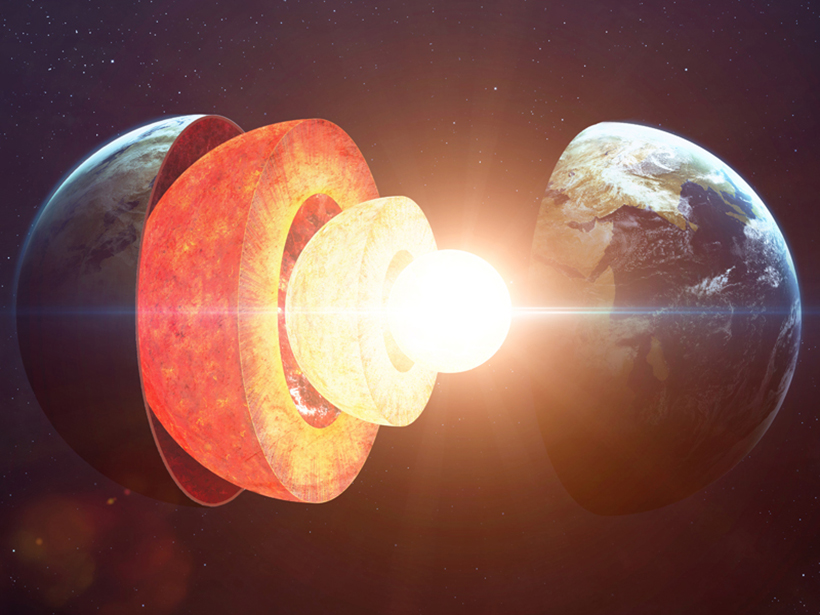When it comes to certain fields of science, sometimes you need a tool, and sometimes you need the whole toolbox. The latter is certainly true for scientists who study Earth’s interior. Coming from a spectrum of fields—analytical geochemistry, experimental petrology, global seismology—they must work together, comparing their observations and results to make discoveries. As we move into the second month of AGU’s yearlong Centennial celebrations, we want to recognize these scientists and their interdisciplinary approach to studying our planet.
An international team made up of gas geochemists, volcanologists, physicists, engineers, and chemists traveled to Central America as the very model of collaborative research.
In 2017, an international team made up of gas geochemists, volcanologists, physicists, engineers, and chemists traveled to Central America as the very model of collaborative research. By flying small drones into the plumes of outgassing volcanoes, they could directly measure the changes in concentrations of carbon dioxide, sulfur dioxide, and hydrogen sulfide. These data help them not only calculate the emission of volatiles from the deep Earth into the atmosphere but also study how volcanoes interact with the climate or even help tell us when one might erupt.
Some groups are making tools for other scientists. Read about the team that created the latest version of the Antarctic Digital Magnetic Anomaly Project (ADMAP-2). Using one observational tool—measuring Earth’s magnetic subtleties—they more than doubled the size of the Antarctic map that will be used by geologists and geophysicists studying the planet’s crust. Similarly, a group from the U.S. Geological Survey recently created a catalog of 15,000 microquakes—those magnitude 3 and below—in Oklahoma to study the effects of wastewater reinjection by petroleum operations. Those data have already allowed the team to study clusters of the tiny quakes and how they radiate out from certain locations, work that may very well lead to changes in local fracking law.
When an M7.1 earthquake struck the city of Puebla in 2017, the team was able to study the biggest test of the system since its implementation. And the wondrous part? The system is working.
The most obvious challenge faced by scientists who study Earth’s interior is simply that they can’t look into it. As a result, they’re forced to create more and better tools that allow them to observe and model what’s happening underneath our feet. Seismologists understand this better than most. It was, after all, Inge Lehmann who studied waves traveling through the planet and discovered, in 1936, that Earth’s outer core is liquid. Not quite as grand observational tools can be useful too: One geophysicist is using synthetic material in a lab to create 3-D movies that model fracturing. Scientists who study these events, caused by anything from earthquakes to melting glacier ice or even plant roots pushing into rock, are rarely able to see them in real time. These new lab techniques can allow them to try to re-create and observe the process.
Finally, some of that science will have a direct impact on our lives. Our February cover story features the work of seismologists and social scientists studying the effectiveness of earthquake early warning systems in Mexico City. After a devastating M8.0 earthquake in 1985 killed around 10,000 people, a research and development group set about finding a way to give their neighbors some warning. When an M7.1 earthquake struck the nearby city of Puebla in 2017 on the anniversary of the Mexico City quake, the team was able to study the biggest test of the system since its implementation. And the wondrous part? The system is working. On 3 January, Los Angeles mayor Eric Garcetti announced that the city is the first in the United States to have an early warning earthquake system: a phone app based in part on the research and lessons learned by the team in Mexico.
Perhaps it’s sentimental to say that there’s nothing we can’t do if we do it together, but we don’t need to say it; we can let Earth scientists show us.
—Heather Goss (@heathermg), Editor in Chief, Eos
Citation:
Goss, H. (2019), Collaboration reveals what’s beneath the surface, Eos, 100, https://doi.org/10.1029/2019EO115621. Published on 08 February 2019.
Text © 2019. AGU. CC BY-NC-ND 3.0
Except where otherwise noted, images are subject to copyright. Any reuse without express permission from the copyright owner is prohibited.
Text © 2019. AGU. CC BY-NC-ND 3.0
Except where otherwise noted, images are subject to copyright. Any reuse without express permission from the copyright owner is prohibited.

